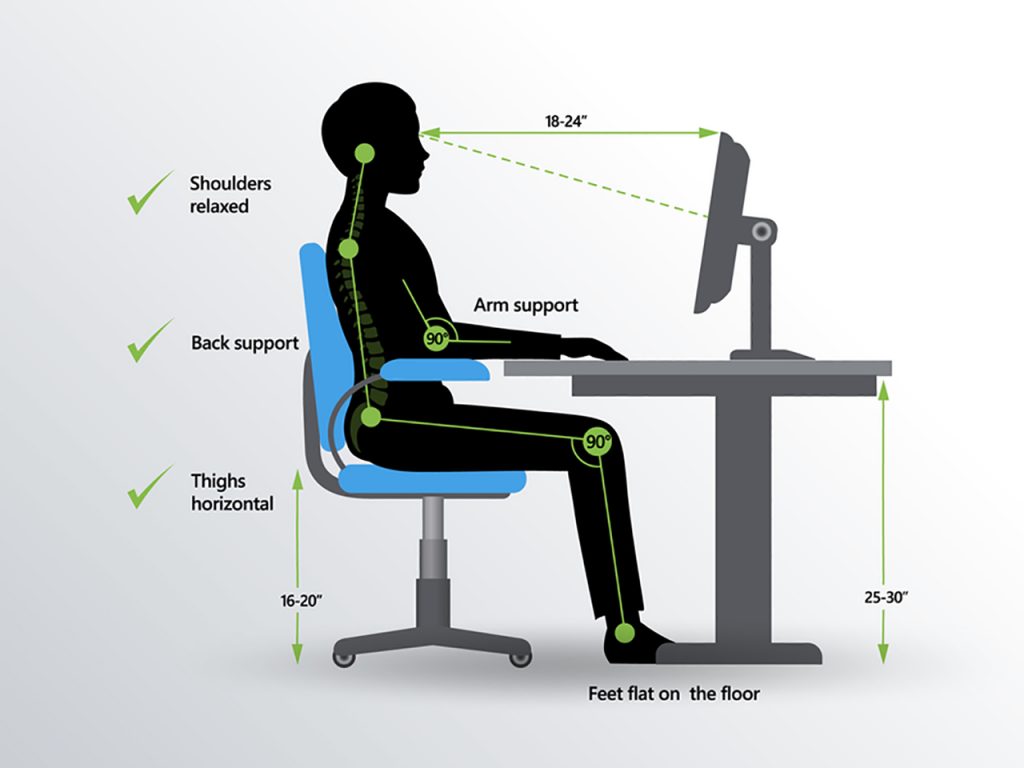In the modern office environment, ergonomics plays a crucial role. It’s more than just a buzzword; it’s a science that can significantly impact our health and productivity.
Ergonomics, in essence, is the study of people’s efficiency in their working environment. It involves designing or arranging workplaces, products, and systems so that they fit the people who use them.
Poor ergonomics can lead to discomfort, injury, and reduced productivity. On the other hand, good ergonomic practices can help prevent these issues, promoting well-being and efficiency.
In this article, we will delve into the top five ergonomic guidelines. These are essential for creating a safe and comfortable office environment.
We will also discuss how to conduct an ergonomic assessment. This is a crucial step in identifying and mitigating potential risks in your workspace.
Whether you’re an employer, an office worker, or a health and safety officer, this guide will provide valuable insights into office ergonomics.

Understanding Ergonomics and Its Importance
Ergonomics is a scientific discipline that focuses on understanding human capabilities and limitations. It aims to ensure that tasks, equipment, and the environment suit each worker.
The goal of ergonomics is to minimize physical strain and discomfort. It also aims to maximize productivity by reducing the risk of work-related injuries.
Ergonomics is not a one-size-fits-all solution. It recognizes that every individual is unique, with different body sizes, strengths, and weaknesses.
Therefore, ergonomic guidelines are essential. They provide a framework for creating a workspace that caters to individual needs and promotes health and efficiency.
The Impact of Poor Ergonomics
Poor ergonomics can have serious consequences. It can lead to discomfort, fatigue, and even injury.
Common issues include musculoskeletal disorders such as carpal tunnel syndrome and back pain. These conditions can result from repetitive movements, poor posture, or inadequate workstation setup.
Moreover, poor ergonomics can also affect productivity. Discomfort and pain can distract workers, leading to decreased focus and increased error rates. Therefore, following ergonomic guidelines is not just about health—it’s also about maintaining a high level of performance in the workplace.
The Five Essential Ergonomic Guidelines for the Office
Ergonomic guidelines are designed to help you create a workspace that promotes health and productivity. They focus on five key areas: chair adjustment and posture, desk setup and organization, monitor and screen placement, keyboard and mouse positioning, and breaks and movement.
- Chair Adjustment and Posture
- Desk Setup and Organization
- Monitor and Screen Placement
- Keyboard and Mouse Positioning
- Breaks and Movement
1. Chair Adjustment and Posture
The first guideline focuses on chair adjustment and posture. Your chair should provide good lumbar support and allow your feet to rest flat on the floor.
Your posture is equally important. Aim to maintain a neutral position, with your back straight and shoulders relaxed.
2. Desk Setup and Organization
Next, consider your desk setup. Your desk should be at a height that allows your elbows to rest at a 90-degree angle when typing.
Keep frequently used items within easy reach to minimize stretching and twisting.
3. Monitor and Screen Placement
Monitor placement is crucial for reducing eye and neck strain. Your monitor should be at eye level and about an arm’s length away.
Avoid glare by positioning your screen perpendicular to windows or other light sources.
4. Keyboard and Mouse Positioning
Your keyboard and mouse should be placed close to each other and within easy reach. Your wrists should be in a neutral position, not bent up or down.
Consider using a wrist rest to help maintain this position.
5. Breaks and Movement
Finally, remember to take regular breaks. Stand, stretch, or walk around every 30 minutes to reduce the risk of musculoskeletal disorders.
Consider using a standing desk or active sitting chair to promote movement throughout the day.
Conducting an Ergonomic Assessment
An ergonomic assessment is a systematic process to identify and address ergonomic risk factors in the workplace. It involves evaluating the physical demands of tasks, the layout of the workspace, and the equipment used.
The goal is to identify areas of concern and implement changes to reduce the risk of injury. This proactive approach can help prevent musculoskeletal disorders and improve overall productivity.
Remember, an ergonomic assessment is not a one-time event. Regular assessments are crucial to ensure that changes are effective and to identify new risks as they arise.
Identifying Risk Factors in the Office
Identifying risk factors is a key part of an ergonomic assessment. These can include poor posture, repetitive movements, and awkward body positions.
Also, consider environmental factors such as lighting, noise, and temperature. These can impact comfort and concentration, and should be included in your ergonomic assessment.
Ergonomic Tools and Equipment
Ergonomic tools and equipment can greatly enhance your workspace. They are designed to promote good posture, reduce strain, and increase comfort.
Choosing the Right Ergonomic Accessories
Choosing the right ergonomic accessories is crucial. These can include adjustable chairs, desks, keyboard trays, and monitor stands.
Remember, what works for one person may not work for another. Personalize your ergonomic setup to meet your specific needs and preferences.
Promoting Ergonomic Practices in the Workplace
Promoting ergonomic practices in the workplace is a shared responsibility. Employers should provide the necessary tools and training, while employees should be proactive in applying ergonomic principles.
Employer Strategies and Employee Training
Employers can promote ergonomics by providing ergonomic training and encouraging regular breaks. Employees, on the other hand, should actively participate in training and apply learned principles to their daily routines.
Conclusion: The Benefits of Following Ergonomic Guidelines
Following ergonomic guidelines can significantly improve health, productivity, and overall job satisfaction. It can reduce the risk of work-related injuries and enhance the quality of work.
Moreover, a well-implemented ergonomic strategy can lead to financial benefits for companies. It can reduce absenteeism, increase employee retention, and foster a culture of health and safety in the workplace.




